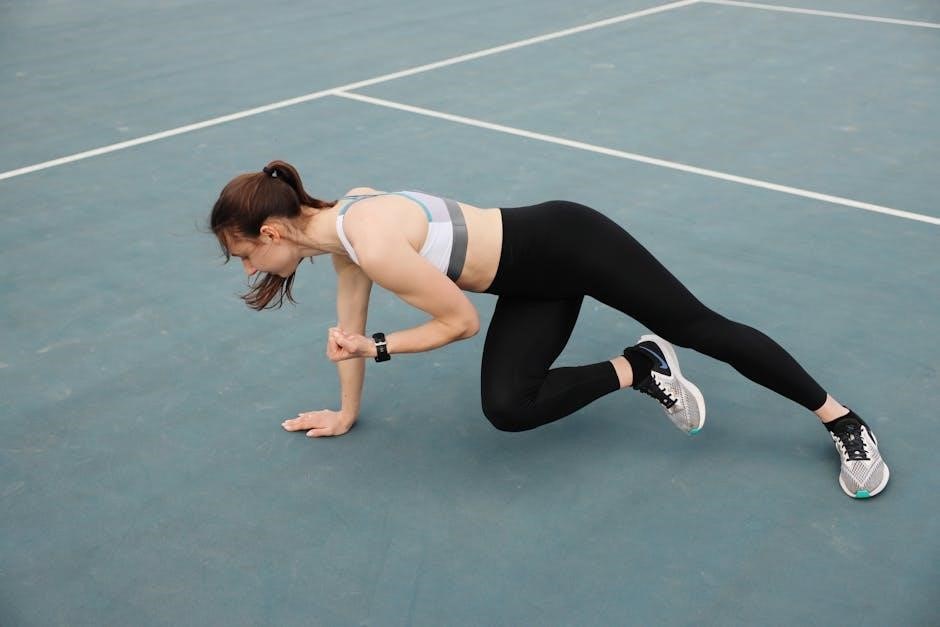Lumbar Fusion Exercises: A Comprehensive Guide
Back pain is a prevalent issue‚ often leading individuals to consider lumbar fusion surgery after conservative treatments fail. This comprehensive guide provides information and exercises to regain strength and mobility. This text includes exercises and activities designed to restore muscle strength and flexibility to your lower back following surgery.

Post-Operative Rehabilitation Phases
Post-operative rehabilitation after lumbar fusion is a structured process‚ typically divided into phases‚ each with specific goals. Phase 1‚ the immediate post-surgical phase (0-8 weeks)‚ focuses on pain reduction‚ inflammation control‚ wound healing‚ and increasing activity tolerance. Precautions are crucial during this period‚ including avoiding flexion and excessive extension/rotation‚ limiting lifting to under 15 pounds‚ and refraining from impact activities for 12 weeks.
Subsequent phases progressively introduce exercises designed to improve flexibility‚ core activation‚ lower limb strength‚ and cardiovascular fitness‚ while ensuring pain-free movement around the fusion site. Physical therapy‚ often regimented at 2-3 times per week for 6-8 weeks‚ plays a vital role. Goals include achieving minimal pain at rest‚ improving scar mobility‚ maintaining erect posture‚ and re-establishing neuromuscular control of lumbar stabilizers. The rehabilitation program advances from supine to quadruped to prone‚ culminating in functional stabilization exercises.
Phase 1: Immediate Post-Surgical Phase (0-8 Weeks)
The initial phase following lumbar fusion‚ spanning from 0 to 8 weeks post-surgery‚ is critical for establishing a foundation for recovery. The primary goals during this period are to decrease pain and inflammation‚ encourage wound healing‚ and increase overall activity tolerance. This phase emphasizes protection of the spine during the healing process‚ with specific precautions to avoid compromising the surgical site.
Patients are typically advised to avoid flexion motions‚ as well as extension and rotation beyond neutral. Lifting restrictions are strictly enforced‚ usually limiting weight to no more than 15 pounds. Impact activities are also prohibited during this phase to prevent undue stress on the healing fusion. The focus is on gentle movements and exercises that promote circulation and prevent stiffness‚ while adhering to the surgeon’s guidelines and physical therapist’s instructions.
Exercises for Flexibility and Core Activation (Weeks 6-16)
Between weeks 6 and 16 post-surgery‚ the focus shifts to incorporating exercises that enhance flexibility and activate the core muscles. These exercises are designed to promote lower limb strength and cardio fitness‚ without disturbing the fusion site’s healing. Pain should not be present during these exercises. At this stage‚ regimented outpatient physical therapy is essential‚ typically involving 2-3 sessions per week for 6-8 weeks.
The goals during this period include reducing pain to a minimal level (0-2/10 at rest)‚ improving scar mobility‚ and maintaining an erect posture for most of the day. Furthermore‚ re-establishing neuromuscular control of the lumbar stabilizers is crucial for long-term spinal health. The exercises help regain proper movement patterns‚ enhance spinal support‚ and improve overall functional capacity. Regular assessment‚ including tools like the ODI and FABQ‚ helps monitor progress and adjust the exercise plan accordingly.
Precautions After Lumbar Fusion
Following lumbar fusion surgery‚ adhering to specific precautions is crucial for optimal healing and preventing complications. A primary precaution involves avoiding flexion motions and excessive extension or rotation beyond a neutral position. For the initial 12 weeks‚ it’s important to limit lifting to less than 15 pounds and abstain from high-impact activities that could stress the fusion site.
Driving should be restricted to short intervals‚ less than 30 minutes at a time‚ and only when you are off pain medication‚ usually after 2-4 weeks. Maintaining proper posture and body mechanics is essential for all daily activities. It’s critical to avoid prolonged static or uncomfortable postures that can strain the spine. These precautions are designed to protect the surgical area‚ facilitate bone graft healing‚ and ensure the stability of the fused segments during the initial recovery phase. Always consult with your physical therapist and surgeon for personalized advice.
Importance of Physical Therapy
Physical therapy plays a pivotal role in the recovery process after lumbar fusion surgery. A structured physical therapy program is essential for regaining strength‚ mobility‚ and function. Physical therapy is a structured plan that supports patients in regaining strength and mobility‚ ensuring a smoother recovery and better long-term outcomes. It helps to relieve pain and restore function.
A physical therapist guides patients through a progressive exercise regimen tailored to their individual needs and recovery stage. These exercises focus on improving flexibility‚ core stability‚ and lower limb strength. A physical therapist also educates patients on proper posture‚ body mechanics‚ and activity modification to prevent re-injury. Physical therapy helps patients return to work and other physical activities.
This comprehensive approach not only facilitates physical healing but also empowers patients to manage their pain and improve their overall quality of life; Regular physical therapy sessions provide ongoing assessment and adjustments to the treatment plan‚ ensuring optimal progress and minimizing the risk of complications.
Goals of Post-Operative Exercise
The primary goals of post-operative exercise following lumbar fusion are multifaceted‚ aiming to restore function and improve overall well-being. One key objective is pain reduction‚ with exercises designed to alleviate discomfort and promote healing. Another crucial goal is to improve scar mobility and promote wound healing. Increasing activity tolerance is also a primary goal.
Exercises also aim to reestablish neuromuscular control of the lumbar stabilizers‚ ensuring proper spinal alignment and stability. Maintaining erect posture throughout the day is another important aim. Improving positional tolerances for return to work is a further goal of post-operative exercise‚ enabling individuals to resume their professional activities.
Ultimately‚ the goal is to facilitate a safe and effective return to daily activities‚ improving the patient’s quality of life. It involves a progressive approach‚ gradually increasing the intensity and complexity of exercises as the patient recovers‚ all while minimizing the risk of complications.
Returning to Activity and Work
Returning to activity and work after lumbar fusion requires a gradual and structured approach‚ guided by medical professionals. It’s important to promote AROM after 8-10 weeks.
Initially‚ limit driving to short intervals‚ less than 30 minutes at a time‚ and only when off pain medication. As recovery progresses‚ positional tolerances for return to work need to improve. Reinforce proper posture and body mechanics for all ADLs.

Before returning to work‚ it’s essential to gradually increase activity levels‚ focusing on movements that mimic job-related tasks. This may involve practicing lifting techniques‚ prolonged static and uncomfortable postures‚ and building endurance for standing or sitting for extended periods. Open communication with employers is crucial to ensure a supportive work environment.

Ultimately‚ returning to activity and work should be a collaborative effort between the patient‚ physical therapist‚ and employer‚ ensuring a safe and sustainable transition back to normal life.
Long-Term Spine Health
Maintaining long-term spine health after lumbar fusion involves a commitment to consistent exercise‚ proper body mechanics‚ and a healthy lifestyle. Regular physical therapy sessions‚ even after formal rehabilitation‚ can help reinforce proper movement patterns and address any recurring pain or stiffness.
It’s essential to continue performing exercises that strengthen the core and back muscles‚ improve flexibility‚ and promote good posture. Avoid excessive loads and prolonged static and uncomfortable postures.
Maintaining a healthy weight reduces stress on the spine‚ while a balanced diet provides the nutrients needed for bone and muscle health. Smoking cessation is also crucial‚ as smoking can impair bone healing and increase the risk of complications.
Furthermore‚ adopting ergonomic principles at home and work can help prevent future back problems. This includes using proper lifting techniques‚ adjusting workstations to promote good posture‚ and taking regular breaks to stretch and move around. Long-term spine health after lumbar fusion is a journey‚ requiring ongoing effort and attention to detail.
Addressing Pain and Improving Mobility
Post-operative pain management is crucial for successful rehabilitation after lumbar fusion. A combination of medication‚ physical therapy‚ and lifestyle modifications can help alleviate discomfort and improve overall mobility. Physical therapy plays a vital role in restoring function by addressing muscle imbalances‚ improving flexibility‚ and strengthening supporting structures.
Exercises should be pain-free and gradually progressed as tolerance increases. Scar mobility exercises can help prevent adhesions and improve range of motion.
Manual therapy techniques may be used to release tight tissues and restore joint mobility. Posture training and body mechanics education are essential for preventing future pain and optimizing spinal alignment.
In addition to physical therapy‚ lifestyle modifications such as maintaining a healthy weight‚ practicing proper lifting techniques‚ and avoiding prolonged static postures can help reduce pain and improve mobility. Addressing both the physical and lifestyle factors contributing to pain is essential for achieving long-term success after lumbar fusion surgery. Moreover‚ psychological support can benefit patients experiencing chronic pain.

